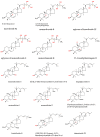Bioactives of Momordica charantia as Potential Anti-Diabetic/Hypoglycemic Agents
- PMID: 35408574
- PMCID: PMC9000558
- DOI: 10.3390/molecules27072175
Bioactives of Momordica charantia as Potential Anti-Diabetic/Hypoglycemic Agents
Abstract
Momordica charantia L., a member of the Curcubitaceae family, has traditionally been used as herbal medicine and as a vegetable. Functional ingredients of M. charantia play important roles in body health and human nutrition, which can be used directly or indirectly in treating or preventing hyperglycemia-related chronic diseases in humans. The hypoglycemic effects of M. charantia have been known for years. In this paper, the research progress of M. charantia phytobioactives and their hypoglycemic effects and related mechanisms, especially relating to diabetes mellitus, has been reviewed. Moreover, the clinical application of M. charantia in treating diabetes mellitus is also discussed, hoping to broaden the application of M. charantia as functional food.
Keywords: Momordica charantia; bioactives; diabetes mellitus; hypoglycemic activity; synergistic effect.
Conflict of interest statement
The authors declare no conflict of interest.
Figures





Similar articles
-
Momordica charantia L. lowers elevated glycaemia in type 2 diabetes mellitus patients: Systematic review and meta-analysis.J Ethnopharmacol. 2019 Mar 1;231:311-324. doi: 10.1016/j.jep.2018.10.033. Epub 2018 Oct 30. J Ethnopharmacol. 2019. PMID: 30385422
-
Immunomodulatory effects and associated mechanisms of Momordica charantia and its phytochemicals.Food Funct. 2022 Nov 28;13(23):11986-11998. doi: 10.1039/d2fo02096c. Food Funct. 2022. PMID: 36350105 Review.
-
In vivo hypoglycemic effect of methanolic fruit extract of Momordica charantia L.Afr Health Sci. 2013 Dec;13(4):933-9. doi: 10.4314/ahs.v13i4.11. Afr Health Sci. 2013. PMID: 24940315 Free PMC article.
-
The Effects of Momordica charantia on Type 2 Diabetes Mellitus and Alzheimer's Disease.Int J Mol Sci. 2023 Feb 28;24(5):4643. doi: 10.3390/ijms24054643. Int J Mol Sci. 2023. PMID: 36902074 Free PMC article. Review.
-
The safety and efficacy of Momordica charantia L. in animal models of type 2 diabetes mellitus: A systematic review and meta-analysis.Phytother Res. 2021 Feb;35(2):637-656. doi: 10.1002/ptr.6853. Epub 2020 Sep 14. Phytother Res. 2021. PMID: 32929814
Cited by
-
Promotion of chronic wound healing by plant-derived active ingredients and research progress and potential of plant polysaccharide hydrogels.Chin Herb Med. 2024 Nov 29;17(1):70-83. doi: 10.1016/j.chmed.2024.11.005. eCollection 2025 Jan. Chin Herb Med. 2024. PMID: 39949811 Free PMC article. Review.
-
Molecular Docking and In Silico Predictive Analysis of Potential Herb-Drug Interactions Between Momordica charantia and Miglitol.Cureus. 2025 May 26;17(5):e84852. doi: 10.7759/cureus.84852. eCollection 2025 May. Cureus. 2025. PMID: 40568278 Free PMC article.
-
Comparative Effect of Individual Herbs and Their Combination on Sucrose Tolerance in Normoglycemic Rats and Assessment of Sensory and Nutritional Attributes of Fortified Bread With Polyherbal Formulation.Cureus. 2025 Jan 22;17(1):e77806. doi: 10.7759/cureus.77806. eCollection 2025 Jan. Cureus. 2025. PMID: 39991425 Free PMC article.
-
Effects of 6-Shogaol on Glucose Uptake and Intestinal Barrier Integrity in Caco-2 Cells.Foods. 2023 Jan 21;12(3):503. doi: 10.3390/foods12030503. Foods. 2023. PMID: 36766032 Free PMC article.
-
Developments in the study of Chinese herbal medicine's assessment index and action mechanism for diabetes mellitus.Animal Model Exp Med. 2024 Aug;7(4):433-443. doi: 10.1002/ame2.12455. Epub 2024 Jul 7. Animal Model Exp Med. 2024. PMID: 38973219 Free PMC article. Review.
References
-
- ADA Classification and diagnosis of diabetes. Diabetes Care. 2015;40:S11–S24. - PubMed
Publication types
MeSH terms
Substances
LinkOut - more resources
Full Text Sources
Medical

